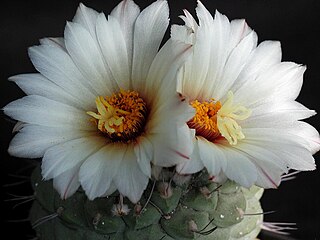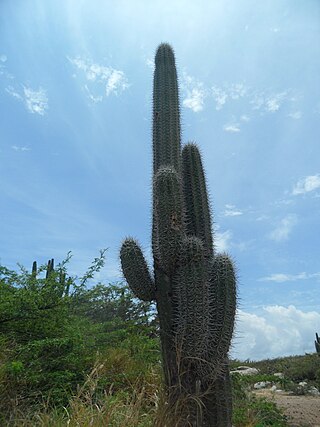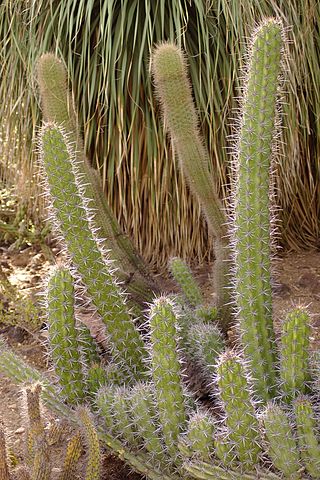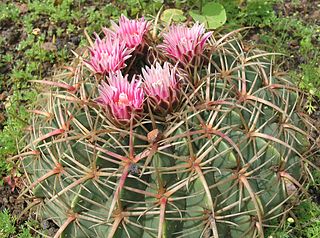
Strombocactus disciformis is a rare species of cacti and the only species of the genus Strombocactus. The plant originates from Central and Northeast Mexico.

Lophophora diffusa, commonly known as false peyote, is a species of plant in the family Cactaceae and one of the species in the Lophophora genus. It is endemic to Mexico in the outskirts of Querétaro. This species contains zero to trace amounts of mescaline. Instead, pellotine is the principal alkaloid - the psychoactive effects of which are comparatively minimal. The species name diffusa refers to the flat tubercles that are outspread without the plant having prominent ribs.

Ferocactus glaucescens, the glaucous barrel cactus, is a species of flowering plant in the family Cactaceae, native endemic to México.

Ferocactus echidne is a barrel cactus in the genus Ferocactus. It is found in nature in Mexico. This cactus is known commonly as Sonora barrel, Coville's barrel cactus, Emory's barrel cactus, and traveler's friend. This plant is often sold as a houseplant.

Stenocereus alamosensis is a species of cactus native to Mexico.

Lophocereus marginatus is a species of plant in the family Cactaceae. It is sometimes called Mexican fencepost cactus.

Cylindropuntia echinocarpa is a species of cactus known by the common names silver cholla, golden cholla, and Wiggins' cholla. It was formerly named Opuntia echinocarpa.

Stenocereus griseus, also known as the Mexican organ pipe, dagger cactus, pitaya, and pitayo de mayo, is a species of cactus.

Cochemiea conoidea, common name Texas cone cactus or Chihuahuan beehive, is a species of cactus native to southern United States to central Mexico.

Echinocereus pectinatus is a species of hedgehog cactus.

Thelocactus leucacanthus is a species of cactus. It is endemic to Mexico.

Ferocactus gracilis, the fire barrel cactus, is a species of Ferocactus from Northwestern Mexico. This cactus gets its common name from the striking red coloration of its defensive spines and flowers.

Ferocactus histrix, also known as Acitrón barrel cactus is a species of Ferocactus native to central Mexico. It is a large barrel cactus that can be commonly found throughout all the Central Mexican matorral. It produces an edible fruit appreciated for its sour taste.

Stenocereus pruinosus is a species of cactus. It is endemic to Mexico and occurs in the states of Veracruz, Puebla, and Oaxaca.

Stenocereus gummosus is a flowering plant in the family Cactaceae that is found in Baja California, Mexico at elevations of 9 to 134 meters

Ferocactus macrodiscus is a species of cactus in the genus Ferocactus from Guanahuato and Oaxaca States, Mexico.

Stenocereus heptagonus is a species of cactus.
Stenocereus martinezii is a species of flowering plant in the family Cactaceae, native to Sinaloa in Mexico. A candelabriform cactus typically 5 to 7 m tall, it is easy to propagate from cuttings, so local people use it to build live fences.

Stenocereus treleasei, commonly known as tunillo, is a species of flowering plant in the family Cactaceae, native to Oaxaca in Mexico.

Cochemiea poselgeri is a species of Cochemiea found in Mexico





























